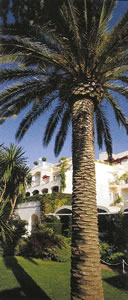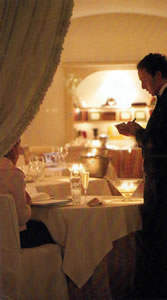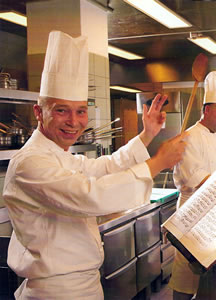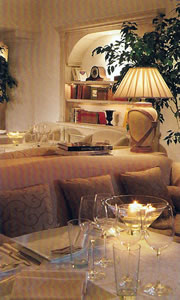Home -
Austria -
Benelux -
Channel Islands -
France & Monaco -
Germany -
Poland -
Russia -
Spain -
Sweden -
Switzerland -
Turkey -
United Kingdom -
United States
Back to reviews in Italy
CAPRI
ANACAPRI
RESTAURANT L’OLIVO,
CAPRI PALACE HOTEL
 Anacapri means ‘above Capri’, in Greek. This little town is, indeed, perched near to the top of the island’s cliffs. It is not right at the top. To achieve the very summit you must clamber onto a chair lift and sway heavenwards for a few minutes – something which I, for one, am not prepared to do. (I have been a close friend of Mr Vertigo for many years.) Still, I like the town. From it the views are so beautiful that they must surely enhance the lives of all those who gaze upon them. They are enjoyed by the many visitors and by those few who are fortunate enough to occupy its crumbling (but very grand) villas. And, from 1960, they have been available to the guests of the Capri Palace Hotel. But I sought out this renowned hostelry not for the views, but for the food in its dining room. For L’Olivo, with its one Michelin star, is regarded as the finest restaurant on the Isle of Capri.
Anacapri means ‘above Capri’, in Greek. This little town is, indeed, perched near to the top of the island’s cliffs. It is not right at the top. To achieve the very summit you must clamber onto a chair lift and sway heavenwards for a few minutes – something which I, for one, am not prepared to do. (I have been a close friend of Mr Vertigo for many years.) Still, I like the town. From it the views are so beautiful that they must surely enhance the lives of all those who gaze upon them. They are enjoyed by the many visitors and by those few who are fortunate enough to occupy its crumbling (but very grand) villas. And, from 1960, they have been available to the guests of the Capri Palace Hotel. But I sought out this renowned hostelry not for the views, but for the food in its dining room. For L’Olivo, with its one Michelin star, is regarded as the finest restaurant on the Isle of Capri.
1960 cannot be regarded as the greatest year in the history of European architecture, so I was pleased to find the hotel exterior – low and white – not at all displeasing. The interior, however, is in a different league. Its combination of columns, arches, stone floors and vaulted ceilings imparts the feeling of a spacious and well-funded art gallery. And the furnishings reinforce the impression, with antique gilt candlesticks, contemporary sculptures and paintings and huge lamps of the sort used on film sets.
 This air of sophistication is continued in the white and grey dining room, designed by Loro Piana. Here I found cashmere, cotton and soft wool, and walls hung with black and white photographs of Capri in the 1950s. Lit by a multitude of candles, this was very definitely a place for sartorial elegance, and I noticed that both my fellow guests and the staff had dressed accordingly. The Restaurant Manager, Francesco Mussinelli, was exceptionally dapper and the maitre d’, Milko Sartoretti, was also very smart in his black tie. It pleases me enormously when I find that standards are being kept up in this way. It makes me feel that I am not wearing my stiff collar in vain.
This air of sophistication is continued in the white and grey dining room, designed by Loro Piana. Here I found cashmere, cotton and soft wool, and walls hung with black and white photographs of Capri in the 1950s. Lit by a multitude of candles, this was very definitely a place for sartorial elegance, and I noticed that both my fellow guests and the staff had dressed accordingly. The Restaurant Manager, Francesco Mussinelli, was exceptionally dapper and the maitre d’, Milko Sartoretti, was also very smart in his black tie. It pleases me enormously when I find that standards are being kept up in this way. It makes me feel that I am not wearing my stiff collar in vain.
Indeed, there was evidence all around of care and attention to detail. The cutlery was by Sambonet, the water glasses were of Murano glass by Moretti and the wine glasses were by Zafferano. The waiters, in dark striped aprons, were careful to replace the napkins of those who left their places for a moment. I was not simply asked about water. Rather, I was brought the water menu, with descriptions of its 15 offerings. I chose the ‘lightly mineral’ Panna.
 Chef Oliver Glowig was born in Germany. He has worked at Le Gourmet in Munich and with the famous Italian chef, Gualtiero Marchesi. Apart from his considerable culinary skill, he has a painter’s eye. All my dishes were aesthetic as well as gastronomic statements. I found in his cuisine subtle and effective combinations and a proper respect for the integrity of his ingredients. He offers two tasting menus, for 140 euros and 180 euros. My four courses from the carte were 131 euros.
Chef Oliver Glowig was born in Germany. He has worked at Le Gourmet in Munich and with the famous Italian chef, Gualtiero Marchesi. Apart from his considerable culinary skill, he has a painter’s eye. All my dishes were aesthetic as well as gastronomic statements. I found in his cuisine subtle and effective combinations and a proper respect for the integrity of his ingredients. He offers two tasting menus, for 140 euros and 180 euros. My four courses from the carte were 131 euros.
I began with a cold medallion of duck foie gras with barley and aniseed. This was delicious liver, luscious and full of flavour. As I ate it I paused to look across the room at the stone fireplace and then at the three candles floating in water in the glass bowl on my table. This was a moment to savour. Then came ravioli, filled with local cheese and served with tomatoes and fresh basil. I do hope Italy will never abandon its wonderful tomatoes. Elsewhere we are too often forced nowadays to make do with mass-produced, watery, tasteless apologies for tomatoes. My meat was a chicken from Bresse, in two services, with a mustard seed sauce. It came with morels and spectacularly good braised vegetables. Some people maintain that a kitchen should be judged on its vegetables: here such folk would have been in a state of ecstasy. My meal ended with a sophisticated confection: tonka broad beans and citrus fruit mille-feuille.
The wine list is vast, and has a feature new to me. It reproduces, in miniature, the label of each wine offered. Prices begin at 19 euros, for an Umbrian white. From France I noticed 1996 Haut Brion for 640 euros and 1999 Yquem for 650 euros, and from California there is 1997 Opus One for 580 euros. Of Italy’s best, the following caught my eye: 1997 Solaia (500 euros), 1997 Tignanello (280 euros), 1998 Ornellaia (280 euros) and 1999 Sassicaia (370 euros). Guided by the excellent sommelier, Giovanni Guida, I enjoyed a local Greco di Tufo, a good balance of acidity and candied lemon (Feudi San Gregorio, 2003 – 27 euros). Then there was a real treat. Luce, from Tuscany, is now one of my favourite Italian red wines. This 1999 was big, luscious, complex, sweet and long-lasting – absolutely delicious (Frescobaldi – 145 euros).
With this good drink inside me, my exit from the hotel seemed slightly surreal – for one walks down a slope and through a tunnel with the glass wall of a swimming pool on one side. As my taxi took me back to my lodgings, I decided that my visit to the Restaurant L’Olivo had, indeed, been a bit magical – in the very best sense.
RESTAURANT L’OLIVO
Capri Palace Hotel, via Capodimonte 2, 80071 Anacapri, Capri, Italy.
Telephone +39 081 9780 111
Fax +39 081 8373 191
Email: info@capri-palace.com
www.capripalace.com
Open April to October